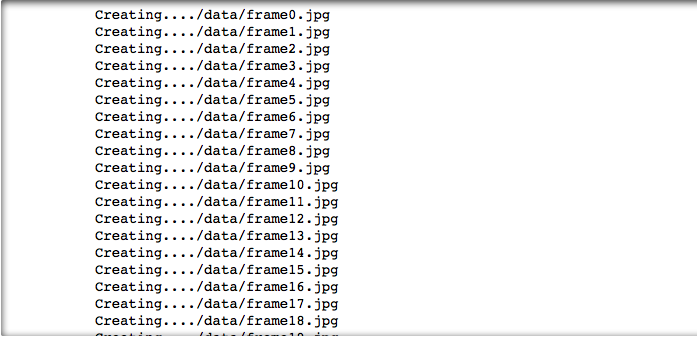

- #Python ffmpeg extrac first 100 frame of video install#
- #Python ffmpeg extrac first 100 frame of video code#
This tells me a lot of the overhead is just in ffmpeg initializing, opening the file, etc.Ī very naive approach might be to extract all frames to disk and then pick off the ones desired.

Therefore, if I wanted say 40 frames from this file, I'd be waiting at most 12 seconds, whereas the entire file's decode time is half that. The same file can be decoded to null in only 6 seconds. For only three frames it might not be too bad, but if I wanted to extract a list of, say, 100 or 200 or more frames, it quickly gets unwieldy even for files with good keyframes.Ī very rudimentary test showed that for a test file, five minutes long, with keyframes every 5 seconds, each invocation of ffmpeg takes an average of about 0.22 seconds to run, with the fastest being 0.11 and the slowest being 0.34 seconds. If you assume the worst case (no usable keyframes) then the most efficient way to extract the frames would be to decode the stream once and pick off each frame as it occurs. The problem with this approach is it seems to be resource intensive for a few reasons: running ffmpeg over and over incurs process overhead, and if the video has distant keyframes (or in the worst case none at all) then the decoder must decode several frames for each invocation. I can do this one frame at a time: ffmpeg -i video.mp4 -ss 1.4 -frames 1 frame_1_4.jpgįfmpeg -i video.mp4 -ss 5.6 -frames 1 frame_5_6.jpgįfmpeg -i video.mp4 -ss 10.5 -frames 1 frame_10_5.jpg I just need the first frame so I modified it this way: def getFirstFrame(videofile): vidcap cv2.VideoCapture(videofile) success, image vidcap.read() if success: cv2.imwrite('firstframe. We use fast seeking to go to the desired time index and extract a frame, then call ffmpeg several times for every time index.

1.4, 5.6, 10.5, etc.įor each timestamp, I want to extract the nearest frame and save it to a jpeg file. Hi, I think it's gonna extract ALL the frames from the video file. That's it! I hope this quick tutorial helped you out extracting metadata of any media file.įinally, if you're a beginner and want to learn Python, I suggest you take the Python For Everybody Coursera course, in which you'll learn a lot about Python.Suppose I have a list of timestamps, e.g. 'codec_long_name': 'MP3 (MPEG audio layer 3)', Below is a run on an MP3 file: $ python extract_media_metadata.py zoo.mp3 That's a lot of information including the duration in seconds, sample rate, codec information, and a lot more. I'm going to run it on a video file: $ python extract_media_metadata.py zoo.mp4 We also use pprint instead of print, so it'll print the Python dictionary in a human-readable way. The ffmpeg.probe() method uses the ffprobe command under the hood.
#Python ffmpeg extrac first 100 frame of video code#
We're getting the media file path from the command-line arguments, so we don't have to modify the code whenever we want to extract the metadata of a new media file. # uses ffprobe command to extract all possible metadata from the media file # read the audio/video file from the command line arguments However, ffmpeg-python seems to work well for both simple and complex usage.īelow is the code responsible for extracting the metadata: import ffmpegįrom pprint import pprint # for printing Python dictionaries in a human-readable way There are a lot of Python wrappers of FFmpeg.
#Python ffmpeg extrac first 100 frame of video install#
Once you have it installed, you need to install the Python wrapper: $ pip install ffmpeg-python Use this link to get it installed in your environment. To make everything work properly, you need to install FFmpeg. In this quick tutorial, you will learn how you can extract video or audio metadata in Python using FFmpeg. Video metadata is all available information about a video file, such as width, height, codec type, fps, duration, and many more. There are many reasons why you want to include the metadata of a video or any media file in your Python application. Disclosure: This post may contain affiliate links, meaning when you click the links and make a purchase, we receive a commission.


 0 kommentar(er)
0 kommentar(er)
